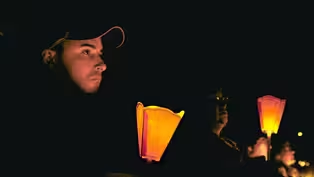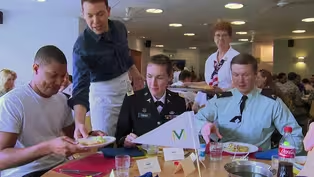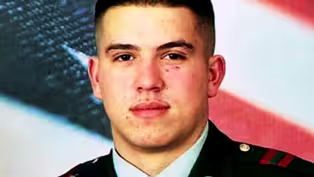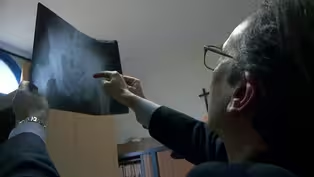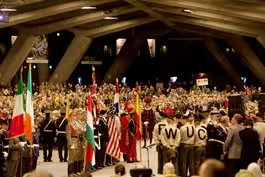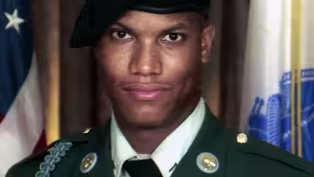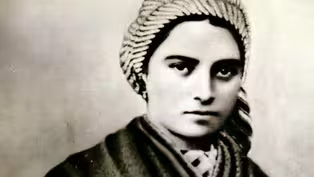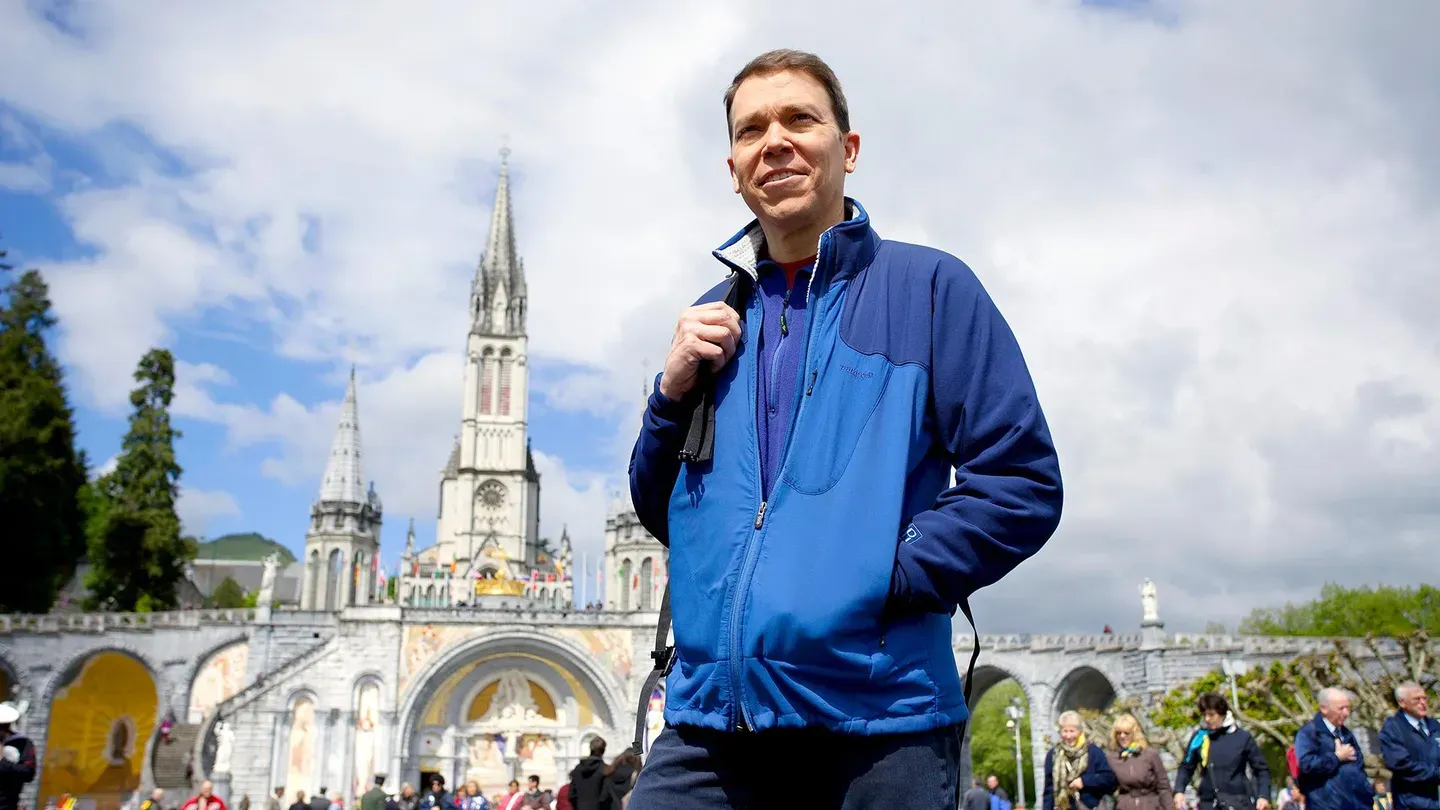

Lourdes
Episode 1 | 54m 50sVideo has Closed Captions
Premieres Tuesday, December 16, 8/7c.
Lourdes has become one of the holiest Catholic pilgrimage sites in the world, visited annually by more than five million people who come in search of healing from its sacred waters. Since the end of World War II, soldiers from around the world have journeyed to Lourdes seeking healing and unity with one another at a week-long gathering known as the International Military Pilgrimage.
Problems playing video? | Closed Captioning Feedback
Problems playing video? | Closed Captioning Feedback
Funding for Sacred Journeys with Bruce Feiler provided by Cancer Treatment Centers of America, Hans and Margret Rey/Curious George Fund, The Pew Charitable Trusts, The Arthur Vining Davis Foundations, the Corporation for Public Broadcasting, and by public television viewers.

Lourdes
Episode 1 | 54m 50sVideo has Closed Captions
Lourdes has become one of the holiest Catholic pilgrimage sites in the world, visited annually by more than five million people who come in search of healing from its sacred waters. Since the end of World War II, soldiers from around the world have journeyed to Lourdes seeking healing and unity with one another at a week-long gathering known as the International Military Pilgrimage.
Problems playing video? | Closed Captioning Feedback
How to Watch Sacred Journeys
Sacred Journeys is available to stream on pbs.org and the free PBS App, available on iPhone, Apple TV, Android TV, Android smartphones, Amazon Fire TV, Amazon Fire Tablet, Roku, Samsung Smart TV, and Vizio.
Buy Now

Meet the Pilgrims
Meet pilgrims from the Hajj, Shikoku, Jerusalem, Lourdes, Kumbh Mela, and Osun-Osogbo pilgrimages.Providing Support for PBS.org
Learn Moreabout PBS online sponsorshipBRUCE FEILER: Each year, more than five million pilgrims travel here-- to the Catholic shrine of Lourdes in Southwest France.
Together, we pray.
FEILER: They come seeking healing.
MAN: Embrace whatever happens.
It's all part of the experience.
FEILER: Every spring, the shrine hosts a unique event.
MAN: Wounded Warrior, Wounded Warrior.
FEILER: Tens of thousands of soldiers from around the world gather for a journey of peace and reconciliation.
I'm traveling with 40 wounded warriors from the United States.
But what are they searching for?
MAN: There's something special about this place.
You've got to have faith.
You know, that's really what this place teaches you.
FEILER: Today, organized religion is more threatened than ever, yet pilgrimage is more popular than ever.
I'm Bruce Feiler.
In this epic series, I travel with American pilgrims on six historic pilgrimages.
I bathe in the rivers of India, dance in the heart of Africa, cleanse in the waters of Lourdes, trek through the temples of Japan, and walk in the footsteps of prophets in Mecca and Jerusalem.
I attend some of the most spectacular and moving human gatherings on earth.
And I ask, what can these journeys tell us about the future of faith?
FEILER: More than two and a half million Americans have served in Iraq and Afghanistan.
One in five returned disabled.
These veterans received medical treatment, but many long for a different kind of healing.
At JFK airport in New York, a group of American soldiers injured in recent wars gather for an unusual journey.
For many of these combat veterans-- traumatized, unable to rejoin their families-- it's a chance at peace.
We've been granted unprecedented access.
Many of these soldiers have traveled directly from Walter Reed Army Medical Center near Washington, D.C.
I was hit by a suicide bomber.
52 people died that day.
It's a lot of people.
I saw a lot of things, saw a lot of death.
And watched... you know, watched my squad members die.
So it's pretty traumatic.
This trip, maybe this will help me find solace in the deaths that happened.
Glad you made it.
So am I.
Looking forward to your trip?
It's going to be fun.
FEILER: Zach Herrick was injured in the mountains of northeast Afghanistan.
ZACH HERRICK: I'm from a small town in Kansas.
I joined in 2010, and after that I was deployed to Afghanistan.
Pretty much just a rifleman.
Just kind of point and shoot, you know?
And that's the basis of what I did.
So I was there for three and a half months before I got injured.
You're welcome, sir, enjoy your flight.
HERRICK: Life isn't a fairy tale, you know?
The prince doesn't always get the princess.
You know, the good guy doesn't always win.
FEILER: Nerves are high at the outset.
For some of these soldiers, it's the first time they've boarded a plane since being flown home after their injury.
Thank you very much, sir.
By the way, I appreciate you, all right?
Thank you.
WILLIAM FISHER: I was injured in Iraq in 2009.
I've been deployed about nine times-- to Panama, Kosovo, Greece.
Done a lot of different places overseas.
Everyone's coming for a reason.
Everyone has some baggage.
So you've just got to open up.
FEILER: Will Fisher and his wife Gayle were shaken by his injuries.
Thank you for everybody here today.
Blessed art thou... FEILER: For them, like all these pilgrims, this journey is an opportunity to escape their day-to-day challenges and seek a new path.
And let's not forget the folks at the airport who made this jog, getting through all this.
FEILER: The soldiers are flying to a remote French town on the mountainous border with Spain.
Lourdes is an improbable destination for a pilgrimage.
Unlike many sacred sites, no ancient events took place here.
But in 1858, a 14-year-old peasant girl named Bernadette announced she had 18 encounters with the Virgin Mary in this unassuming town.
Lourdes has become one of the holiest Catholic pilgrimage sites in the world, visited by more than five million people a year.
(crowd singing) FEILER: Like many pilgrimage sites, a chief lure of Lourdes is what many consider the healing power of its waters.
Those waters come from a spring where Bernadette said she encountered the Virgin.
Beginning after World War II, soldiers from around the world have come one weekend each year to seek healing in those waters and unity with one another.
These hardened soldiers would seem to have little in common with this young girl.
What draws them?
Is it physical healing, emotional healing, or something more, something we all need?
The injured soldiers arrive several days before the start of the International Military Pilgrimage.
Their weeklong stay is sponsored by a Catholic volunteer organization that brings sick and injured pilgrims to Lours several times a year.
Almost half these soldiers are not Catholic.
Organizers believe anyone can find relief here.
It's a chance to reconnect with your higher power, whatever that higher power is.
And we say to them, like, "You come and you participate insofar as you can."
It's a time to get away, a time to reflect, a time to refocus for the future.
And welcome to Lourdes.
Safe trip, good trip?
Great, amazing.
FR.
O'GRADY: When they come in to Walter Reed, they're pretty discouraged.
So you have to take them day by day, bit by bit.
PRIEST: Welcome to Lourdes.
FR.
O'GRADY: Stress and uncertainty is a big part of their life because of their injuries, because they're trained to do everything.
Young adults don't like to be dependent.
And so we have to help them to turn the corner and realize we're here to help.
They've done their job.
They need to get well.
Religion and prayer can help them to do that.
FEILER: The wounded soldiers are joined by dozens of volunteer support staff, all of whom pay their own way.
Together they live in this special facility within the Lourdes Sanctuary that's halfway between a hospital and a hotel.
(whistling) Hey, there we go.
There's something that draws us, and it's the mother of God, the grace that's here.
We're all on the pilgrimage, because we don't just live here for one week in this holy place and this extraordinary experience and then go home and stop.
It goes with us.
It's a ripple effect.
FEILER: Retired Army Staff Sergeant Juan Roldan is here with his girlfriend, registered nurse Litzka Sandoval.
He was wounded in Iraq in 2006.
That's how I get in the bed.
I was born and raised Catholic, and I definitely feel like God has a plan for me.
It is for me to find out what that is.
When I first got injured, when I was waking up, when I was having nightmares, when I was having anger issues, when I felt like... like there was nothing for me... like, why me?
I felt worthless.
I felt like...
I felt...
I felt like I wasn't enough, like I would have been better off dead.
FEILER: Today the wounded soldiers and volunteers gather to reveal why they've come to Lourdes and what they're hoping to gain during their stay.
This is Juan's second pilgrimage since his injury.
This is a unique experience.
For the people that have never been here, you'll see as the days go by that you'll notice a change within yourself, within your heart, within your mind, with your spirit.
It's been about seven months since I got hit.
I got hit by a suicide bomber in Afghanistan.
Took three of my buddies.
MAN: Hi, I'm Chris Paiser.
If you can't figure it out, I'm blind.
I was wounded in 2004 over in Balat, Iraq.
I was an infantryman, like many of you out there.
I was also a combat engineer.
People ask you how you feel, and damn it, I'm a soldier, I'm a man, I feel fine.
FEILER: Captain Hugh Fisher is another returning pilgrim.
He served with the British Army before becoming an American citizen.
FISHER: And I ended up going into the U.S. Army after 9/11.
And I will be absolutely candid with you.
At the end of my time in Iraq, I'm sitting there with the barrel pointing at my chest, because I've decided obviously I don't want to shoot myself in the head, because that will leave a mess for the children.
And part of my healing was coming here.
If you see me kind of on my own in the back every now and then, it's probably because I'm dealing with a bad day.
I spent a year living with the Afghans.
FEILER: Being in this sacred place allows these wounded warriors to access feelings they may have hidden from others, and even from themselves.
Most of these soldiers are not used to speaking openly about their pain.
It's taken a lot for me to get up here and talk to you all.
I've pretty much kept to myself any stuff that I've gone through.
I have nine deployments.
My wife is my fifth wife due to my deployments, so it's hard on families.
I've got pictures and pictures of Marines that I can't see anymore.
I've got pictures and pictures of my Army brothers and sisters that I can't see anymore.
Each one of us has gone through something totally different, but yet we're all the same.
I feel like... like I'm home when I'm surrounded by other veterans.
You know, we all raised our hands, we all went through the training, we all laced up our boots, put on our camos and stepped up to the plate when it was needed to.
I lost my legs.
I have a spinal cord injury.
I suffered traumatic brain injury.
But I have so much more in common with the other veterans than that.
FEILER: The hospital complex is across the river from the heart of the shrine.
With more than 23 separate chapels and sanctuaries, including the Rosary Basilica with its grand ramps curving out into the manicured square, Lourdes is sometimes criticized as being overly ornate.
But the emotional heart is around back, at the site of the original vision.
This is the grotto where Bernadette first encountered the apparition that identified itself as the Virgin Mary.
You can see the basilica actually grows out of the rock.
Inside the grotto is the spring which Bernadette says the Virgin told her to drink from and bathe in.
For pilgrims, this water is central.
Some drink it, others bottle it to take home.
But for many, the highlight of their stay is when they enter a private chamber and bathe in the water itself.
Some expect to be cured physically, while others hope for a general blessing of good health, or to be relieved of psychological burdens.
PRIEST: We pray to the Lord.
CONGREGATION: Lord, hear our prayer.
FEILER: Sergeant James Pierce is in search of emotional healing.
He's been treated for the shrapnel injuries to his leg and upper body, but like many, his heart is still broken.
PIERCE: I lost my whole squad.
A suicide bomber came up and detonated himself.
It blew me on my back.
When I sat up, and well... his head came up and hit me in the head and rolled over.
And I looked at it, and I was like, "You've got to be kidding me."
This, right here, had gotten my artery, so it was squirting about seven feet in the air.
And I'm pretty realistic, so I was like, "All right, I've got about five minutes to live."
I started losing consciousness towards the end of it, because I lost so much blood.
PRIEST: Behold the Lamb of God.
Behold Him who takes away the sins of the world.
Blessed are those called... FEILER: James only recently started walking again.
He's in frequent pain.
I don't think I could have considered myself coming on the pilgrimage before the injury.
The injury has kind of opened my eyes to a lot of things.
FEILER: How much of this, for these soldiers, is about fixing what's broken?
What they've told me is they're looking for healing.
Not necessarily that "cure," but that healing, that internal healing, which is a lot different than looking for a simple cure.
Healing is like... there's nothing neat or magic bullet about it.
The biggest thing they want is encouragement.
I usually tell them, "Just be open.
"Allow your heart, your soul, your mind, your spirit, to open up to what God has prepared for you."
We want you to walk alongside us and guide us... FEILER: When the injured pilgrims arrive, few know much about Lourdes, or about Bernadette Soubirous, the local peasant girl who tended sheep on the mountain hillside overlooking the village.
On Feb 11, 1858, Bernadette was gathering firewood beside the river, near the grotto Massabielle, when she said she first saw the unidentified apparition.
Religious scholar Ruth Harris says stories like this were common in the 19th century.
HARRIS: In this part of the world, many, many apparitions are seen by shepherds and shepherdesses.
Apparitions were often seen as having some relationship with the natural world, and grottos in particular were a place where apparitions occurred.
And the place of Massabielle is very particular.
It's a place that has a reputation for having perhaps supernatural creatures there.
FEILER: Bernadette described seeing a young girl about her age, dressed in white with a blue belt around her waist, standing where this statue is today.
The beautiful apparition didn't speak during that first visit, but wordlessly prayed the rosary with her visitor.
At first no one in town believed Bernadette, including the local priest.
BRIAN de BURCA: Bernadette was a nobody here.
She hadn't made communion, she was 14, couldn't read and write.
The vision says to her, "Will you do me the pleasure of coming here for two weeks?"
And Bernadette never forgot that.
She, little miss nobody, is treated as a person.
She said, "She spoke to me as one person speaks to another."
And I say that is the vision that Lourdes has.
The fragile, the weak, are the most important people.
FEILER: Bernadette said that over time, the apparition eventually identified itself as the Immaculate Conception, a new name for the Virgin Mary.
Stories quickly spread of miraculous cures, and pilgrims began to flood to the spot.
The Church, still skeptical, took four years to investigate before proclaiming in 1862 that Bernadette had truly seen the Mother of God.
HARRIS: The Church in France had gone through terrible upheavals because of the revolution and was longing to reestablish its position.
The Church tries to reconnect the flock to Catholicism, and Mary is seen as the perfect intercessor.
So the Church endorsed the world of piety, and also peasant piety, that Bernadette represented.
In trying to re-Catholicize not only France but large parts of Europe, Lourdes beckoned to those who saw one of the poorest given the gift of the apparition.
FEILER: Lourdes was a poor, isolated village at the time, Bernadette a young, vulnerable girl.
So many of the figures in great revelations like this are usually men-- Moses, Jesus, Buddha, Mohammed.
It's rare to see a young girl.
But maybe there's a connection with Mary, herself young and vulnerable at the time she was visited by the angel.
The Catholic Church has confirmed 11 cases where the apparition of Mary has appeared, including in Fatima in Portugal and in Guadalupe in Mexico.
Since pilgrimages often arise in places where humans encounter the divine, all these sites are heavily visited today.
But among religious sites, Lourdes does something unique.
It attempts to separate matters of science-- such as, is someone medically cured?-- from matters of faith.
It actually has a medical office on the premises itself that evaluates every cure someone claims happened here.
Whenever someone claims they are cured by the waters of Lourdes, the case is evaluated by an international committee of medical professionals.
From the time of Bernadette, there have been skeptics about these stories, including in the Church.
So what do you say to skeptics?
The Office of Medical Observations exists in order to conduct a strictly medical investigation.
So I do not get into the affair of miracles, for instance.
I'm there for a cure.
What we are looking for is to understand if a person was indeed really sick.
If we have a true and real diagnosis for that disease, what was the prognosis of that disease?
What was the treatment that that person received, or the treatments that that person received?
And we want to know if that cure was indeed complete and if that cure is indeed lasting forever.
FEILER: This ongoing conversation between faith and science is one of the things that gives Lourdes its continued appeal.
By introducing the idea of proof, the Church is saying, "We welcome a modern conversation with its questions and doubts."
Retired Army veteran Chris Paiser is on his third trip to Lourdes.
PAISER: I was at the PX in Balat, Iraq.
And it was hit with two missiles.
Just wrong place at the wrong time.
I had two pieces hit me in the right side of the face.
One took out the right eye, and the second one clipped the left optic nerve.
FEILER: There has been no miracle at Lourdes for your friend.
MARY: He wasn't cured visually.
He wasn't cured visually, but he was cured in another way.
I always have a hope for technology to finally catch up and be able to do something.
But since the first time I've come to Lourdes I've grown to accept it more that I may not see the technology.
MARY: He harbored a lot of anger for a long, long time about the fact that he couldn't see.
And when he came the first time, he expected to go in the baths and come out being able to see.
But it wasn't like that last year when he came.
And he took away a sense of peace with it.
...walked the whole way around the village trying to get... find driftwood, and... FEILER: For the pilgrims, walking the streets where Bernadette once walked makes her story more immediate.
Sergeant Monica Southall injured her back and shoulder in Afghanistan and is now medically retired from the Army.
She finds comfort being surrounded by other veterans.
It is always great to exchange stories with other soldiers and learn what they've been through, because they understand.
Especially when it comes to PTSD, which is another thing that I deal with, some people don't actually understand some of the things that go along with this, some of the depression, some of the anger.
And talking to somebody who has gone through the same things, or is currently going through the same things, it makes a world of difference.
And it's raining, awesome!
FEILER: In Lourdes, like in similar sites around the world, pilgrimage is big business.
In this town of 15,000, there are more than 270 hotels.
And with five million visitors seeking blessing from its waters, there's plenty of occasion for excess.
Everything in Lourdes is built around the pilgrimage, and wherever you've got millions of people, you've got millions of trinkets.
We've got statues of the Virgin Mary.
We've got candles of Bernadette.
But the biggest thing for sale is water bottles, as you see, of all sizes here.
And what you do is you take this water bottle, fill it up with waterfrom the grotto, take it back home, and hope for a cure.
For some pilgrims, the commercialism of the town can be disturbing.
It raises tough questions for Zack.
HERRICK: This young little 14-year-old girl saw, you know, Mary in a cave, and then it exploded.
And now we see today little tick-tack stores and stuff like that.
And this town gets a lot of money from visitors coming in and a lot of Catholics.
And to me, selling religion, it just seems kind of, like, disgusting.
If I don't believe exactly, you know, what they believe, it's just kind of...
I don't really believe...
I mean, I believe there's a higher power, obviously.
I think...
I believe that.
But, you know, I don't know what it is.
And so I just keep an open mind.
I don't necessarily believe that you need to go to church to reach God.
I don't really talk about my injury.
A lot of people obviously, like, see me, and it's...
I mean, it's right there.
This, even though it's what it is, hasn't affected how I believe toward God.
Well, I didn't know too much about Afghanistan.
It was just strange, you know, going over there, not knowing the culture or anything, what the... you know, who the enemy is and stuff like that.
We were doing a mission, a patrol.
A village was down the hill supporting Taliban.
So that was the basis of our mission.
We took over this little miniature house, and we came out the back.
That's when I got hit.
That's when I was injured.
I was already down, shooting back, and it felt like a firecracker went off in your mouth.
That's what it felt like-- bam!
A lot of people got injured.
And, you know, my platoon leader, he was shot and killed.
My buddies came up, and they were crying.
I was just bleeding and bleeding.
And it was just helpless.
So... Yeah, just things went through my head.
And I was like, "Yeah, I'm probably going to die, and it's okay."
I was fine with it, to be honest.
I was... sucks, but...
But when you come together, when you talk about it, it helps.
It helps with a lot of demons inside.
FEILER: One of the great gifts of a pilgrimage is the feeling of safety it creates.
Everyone is on the same journey.
FISHER: It's a brotherhood here.
When something has to be done, we come together to complete a mission, no matter what branch of service we are.
The question becomes, is there something greater... FEILER: That camaraderie makes it easier to express your faith, your doubts.
When you first come to a place like Lourdes, your instinct is to attack the story.
Did it really happen?
I believe in science.
But having been to sites like this all over the world, I soon realized that those aren't the most interesting questions.
Far more interesting than what may have happened here in the 1850s is what's been happening here ever since.
Hundreds of millions of people have come here seeking something.
For the pilgrims I'm with, they've had every scientific cure, but they don't feel healed.
They want something more.
Although our pilgrims have been here for days, the full International Military Pilgrimage is only now getting started.
On the streets, a British Army band plays a lament for fallen comrades.
No matter the nationality, all these soldiers have suffered loss.
This is your... well, your war patch.
United States Army Central Command.
It's who I deployed with.
I'm in the medical field.
That's my medical caduceus.
I deployed to Iraq in 2008 with United States Central Command.
FEILER: Sergeant Gustavo Ruiz is a resiliency trainer.
He helps soldiers and their families deal with the stress of war.
A veteran of Iraq and Afghanistan, he, too, was wounded in service.
I was raised Catholic, so I knew exactly what I was getting myself into when I came.
I just wanted to come and relate, mm-hmm.
I've been dealing with some personal things about faith.
And... so coming here was a step for me.
Had some injuries in Iraq, and I don't sleep very well.
I have bad dreams.
Definitely changes in my life that I have seen.
So I guess I fit the mold to come here.
And that's why I'm here.
I fit the requirements, I guess.
FEILER: The presence of so many soldiers from around the world is another part of the healing process for Gustavo.
RU: It's just a great feeling.
It's like bravado.
You go out there and you're representing your country.
It's like the Olympics.
It's amazing-- you feel good about your uniform.
(marching band playing) FEILER: The soldiers have come from across the planet-- Europe, Asia, Africa, the Caribbean, North and South America.
Bringing together former enemies and allies alike, the pilgrimage transcends divisions.
Here, everyone is bound by their shared experience in war and their shared need for peace.
Today we join an international Mass in the main basilica.
Consecrated in 1876, a mere 18 years after Bernadette first told of her encounter with the Virgin, this massive church shows how quickly Lourdes became a major pilgrimage destination.
O'GRADY: All of these soldiers have faith.
And, you know, the combat experience and the loss damages their faith, and the purpose is to give rebirth to it.
PRIEST: You are very welcome here to this great basilica for the opening Mass of our pilgrimage.
FISHER: I've seen people that didn't believe in anything pray and thank God.
PRIEST: We are not alone here.
FISHER: You know, you do what you want, and then be in the middle of this, per se, and all of a sudden everyone's praying.
So everyone believes in something.
ARCHBISHOP: We pray that, like Bernadette, here we might experience the presence of the Virgin Mary and experience her all-embracing love.
FEILER: After Mass, the pilgrims join their fellow soldiers at the formal grand opening of the pilgrimage.
The ceremony takes place in a vast underground basilica beneath the plaza.
It's one of the largest churches in the world.
The Military Pilgrimage began after World War II as a way to reconcile French and German troops.
And look at it now.
It's become a massive gathering.
35 countries are invited.
This room holds 25,000 people, and they come every year for a gathering of faith, healing and camaraderie.
The event feels like an enormous military reunion, each country cheering for its flag.
It shows that pilgrimage, like religion itself, is not always somber.
Spectacle, light and pageantry are part of the appeal.
The fun is particularly important for these wounded warriors, who are anxious to move beyond their pain and just enjoy themselves for an evening.
(priest speaking French) (cheers and applause) After the Masses and the processionals are over, the lights go down on the church and they come up in the town.
The commanders and priests agree to look the other way.
The soldiers flood into town and they do, well, what soldiers do.
How are you?
Good, brother, good.
How's it going?
Good, how are you?
FISHER: It's amazing, because if you look around, you have every branch of service, every country's branch of service, about here.
We've all been fighting against each other, and now we're drinking beer together.
It's intense, it's very intense.
It's going to get crazy before the night's out.
I hope they don't lock the hospital's doors on us.
(laughing) There we go.
Tastes like Coke.
What is that, Pepsi?
Coke and vodka.
FEILER: Captain Hugh Fisher knows the importance for combat veterans of being recognized for who they are and what they've done.
U.S. Marine, U.S. Army.
Wounded warrior, wounded warrior.
FEILER: It's the first time Zack has felt comfortable meeting so many strangers in public since his injury.
HERRICK: It doesn't matter what language you speak.
It's like you can connect on that level, because you're all soldiers.
Everybody seems to really appreciate what we do.
And it's strange to hear that from people who aren't even Americans.
FEILER: So how much of this is about the military and how much of it's about the pilgrimage?
I think the two kind of merge into each other.
When you think of military, you think of kind of that toughness and hardness.
But then when you come here, and having some of our injured service personnel with us, we all of a sudden realize, you know, that there's a real gentleness there that we have for each other, and it's demonstrated hugely in a place like Lourdes.
(church bells ringing) FEILER: Every day, even in the rain, the church celebrates the miracle of transubstantiation.
Priests carry the consecrated wafer that tradition holds becomes the body of Christ down through the shrine.
PRIEST: If we are able to, we are invited to bend on our knees to welcome Our Lord who is coming to earth today.
HARRIS: I think the allure is not just about physical healing, but a healing that goes through the whole being.
And this idea of healing is something that could happen in many contexts.
But there's something about the way the Catholic rites make the relationship between mind and body, the Eucharistic procession, which emphasizes the miracle of Catholic faith, which is transubstantiation.
FEILER: While the Catholic Church doesn't promise cures, it may certify a miracle after the medical office declares that a patient has experienced what it calls an inexplicable cure.
This is the records room, where all the records from all the unexplained cures are kept.
As the director points out, Lourdes is hardly unique.
Spontaneous cures are documented regularly in hospitals around the world.
This is...
So his name is Micheli.
Vittorio Micheli.
Oh, Vittorio Micheli.
In 19... in May of 1964...
He comes here to declare his cure that he claims has happened in '63.
I see, okay.
And they're following Micheli over the years.
and they start also asking, as you can see...
So these are hospital records from his care before he came here and had the alleged cure.
So he was diagnosed with an osteosarcoma.
He was diagnosed... ...pelvis.
That's a cancer?
Yeah, cancer.
A malignancy, with no known treatment at the time.
He arrives in Lourdes, and he has clinical signs of an instantaneous cure, because he... FEILER: In 1976, 13 years after his visit to Lourdes, Vittorio Micheli's case was proclaimed a miracle by the Catholic Church.
Dr. De Franciscis reminds me that Lourdes is not a medical facility.
It's a place of pilgrimage.
DE FRANCISCIS: Lourdes is a place of faith.
This is a shrine.
Lourdes is not a hospital, it's not a clinic.
In every miracle there is sufficient light to believe if you want to believe, and to not believe if you do not want to believe.
So you're comfortable medically saying that there are unexplained cures.
You say hospitals do that, and they're found here.
Do you believe that these unexplained cures might be miracles?
I do believe, I do believe.
I am a Catholic, and I don't think, and frankly I have never thought, that being a Catholic and a doctor, there was any conflict between the informations that I receive from my education had any conflict with what I believe in faith.
It's something I have learned in Lourdes over the years-- it has been that every now and then in life it's so useful to just lift the hands and say, "This I do not understand."
FEILER: Today for many is the crowning moment of the week.
Most of the injured soldiers will bathe in the spring.
More than 350,000 pilgrims each year partake in this ritual.
You strip down.
It's men on one side, women on the other side.
And then they dunk you, and then you come out, and, you know, you dry off, and they say...
I mean, I don't know.
How does it go?
VOLUNTEER: It's like that.
They dunk you completely under.
But, like, it's cold, and they dunk you?
But it's refreshing.
But it's cold.
You won't even realize it.
I bet you don't.
MICHELLE: Gustavo, are you going to bathe?
I haven't really thought about doing it.
Why not?
GUSTAVO: I know it's an opportunity for me, right?
I'm here.
I really don't want to waste anyone's time; just go there and think that, you know, I'm going to go to this place and something's going to happen to me or not.
I'm not trying to be negative-- I'm just being me.
FEILER: Chris Paiser understands Gustavo's reluctance.
The first time he came here, he entered the bath and was disappointed.
PAISER: For me it's hard.
I try not to think about what I really want, because God's... God's not going to give me what I want.
He's going to give me what he wants me to have.
If he seems willing enough to give me the grace to accept it, I would be happy with that.
HUGH FISHER: Perhaps, as Chris said, what you'll be given is actually what you need.
Not what you think you need, but what God thinks you need.
Don't set yourself up for disappointment and failure, but embrace whatever happens.
It's all part of the experience.
JUAN ROLDAN: Last time I was here was three years ago.
I was battling a lot of depression, stress, and just fear of the unknown-- what was going to happen with my daughter.
I definitely prayed for my health.
I was open to everything and anything that they had us do.
And the most beautiful experience that I had while here was when we went to the Grotto.
They get you in the room.
They take your clothes off, they wrap you up in a white sheet.
FEILER: Like the inner sanctum of many religious spots, the baths are modest, unadorned and private.
Cameras are not allowed when pilgrims are present.
Bathing here is a personal, sacred act-- each pilgrim alone with volunteers who assist them into the water.
ROLDAN: Being a man, I felt very awkward at the moment, but I kind of went with it.
I was still very uncomfortable when they placed me in the water.
I was still very uncomfortable.
The water was really cold.
But as soon as they placed that water over my head, I felt a sense of relief within my left side of my body.
The following day I felt a change within me.
I wasn't having as much back pain.
I wasn't having as much pain up my shoulder.
For some reason, my face felt lighter.
I used to have, like, real bad headaches.
And since then I haven't had a severe headache.
I always wanted to come back here.
I... how do I say this?
It's an experience that... it's so unique and everything that it really... it really makes you feel blessed, you know?
I feel lighter, cleansed, relieved, and a sense of peace.
I do.
I'm interested to see what happened with Zack.
Because he wasn't going to come, and somehow got persuaded into it, so...
The shock of the water wasn't as bad as my emotions.
And that in itself was something to grasp.
I feel relieved that I did it.
I feel...
I'm glad I did it.
You feel you can breathe.
You know, after you get out of that cold icy water, you feel something's out of you.
Yeah.
FEILER: Is that water special in some way?
My answer will be chemically, physically, that water is water.
But I think we should respect the expectations and the popular faith of so many millions of people that truly believe that that water is miraculous.
FEILER: Some people say that because people come here hoping to feel better, that that helps them to feel better, that the mind, by turning in that direction of positive thought, can help the body and the soul.
If I can let go of hatred, if I can forgive, that's big healing.
And I...
I mean, I see that.
People think in terms of physical healing, but really, if I can be healed inside in some way, I don't know what you call it, but that happens here.
(marching band playing upbeat tune) FEILER: It's the last day of the pilgrimage.
The sun has broken through.
The pilgrims take some time to enjoy the festivities.
Before saying goodbye, the wounded soldiers, their families and the volunteers reconvene in the hospital to share what they experienced.
It's the ultimate stage of any pilgrimage, when the traveler asks, "What did I learn by coming here?"
HUGH FISHER: We have some very tough soldiers here, very highly trained soldiers, who've been and done and seen some pretty bloody awful things.
And we all carry that in our heads.
I'm the guy who's in there chewing on the nine mil.
And what you have all done for me is to affirm life, and affirm the value of it.
And there's a misconception out there that by talking about things, by expressing things, by putting something out there and owning it, it is somehow weak for a professional soldier to do that.
I'm sorry, I don't see any weak professional soldiers here.
JUAN ROLDAN: God put those soldiers in their place to risk their own life to save my own.
I need to honor them by waking up every day and looking at another opportunity for me to do something in this world.
My daughter gives me that purpose.
My family gives me the strength.
And God gives me the will.
I wanted some type of healing.
That's what I was looking for in this trip.
We're healed a lot more than we may think we are.
It may not be physically, but it may be in other ways that we are.
HERRICK: You've all been really great.
Boy.
Sorry.
I love you guys.
Like, all of you have been beautiful.
And, like, watching you guys smile, like, that's my religion.
That brings me happiness is watching you guys smile.
FEILER: More than 500 American military have made this pilgrimage.
They assemble one last time for the official photograph.
Many of these soldiers are still on active duty.
But for the majority of wounded warriors in our group, their military careers are now over.
Tomorrow they'll return home and try to restart their lives, carrying the lessons of Lourdes.
What they have done to come to this place is a real testament to their human will.
And here they gather for a moment, together, to smile.
PHOTOGRAPHER: Come on, we've got to do the picture.
Hold it first, with a big smile.
At three.
One, two, three.
Cheese!
GROUP: Cheese!
FEILER: The final leg of the pilgrimage is the most communal.
Tonight, thousands of soldiers will march in a silent candlelit procession to the heart of the shrine.
When you go back home, if someone says to you, "What did you learn there, like, what in that place changed in you," what would you say?
My heart and believing, you know?
There's something special about this place.
I don't know what it is, but there is something special here, and I can't...
I don't know how to put it into words.
MARY: Our family was very broken.
After we came last year, he started stepping up to the plate and being the man he was before he went to Iraq.
When he came home, he came home with this idea that he was broken and that he couldn't do anything anymore.
And that was not my belief.
My belief was that he was still the man that I married; he could still be my partner.
He just had to be willing to do it.
WILLIAM FISHER: But I don't think it's coming here and saying, "Hey, fix me."
It's saying, "Hey, it's spiritual here, no matter if you're Catholic or you're not."
Everyone feels something here.
And you've just... you've got to have faith.
And that's really what this place teaches you.
FEILER: The procession will last more than two hours as it weaves through the streets, alongside the river, to the steps of the basilica.
For many of these pilgrims, it's a long time to be on the move.
I'm struck that pilgrimages, no matter where they take place, no matter who comes, are never easy.
They're tough physically, they're tough mentally.
And you throw in the challenges that these wounded warriors have, they're extremely difficult.
And yet when you arrive at the destination, you assemble all these people, and you throw in the light, a pilgrimage can be magical like few gatherings on earth.
(people singing in French) (choir continues singing) FEILER: As the great cross is carried to the front of the basilica, I'm reminded that Lourdes embodies a key message of Christianity... That Jesus invites believers to "“lay their suffering at the foot of the cross"” and seek comfort in the divine.
It's a message in common with many pilgrimage sites around the world.
If you are troubled, curious, sick or unsure, if you have faith, or if you have doubt, come here.
Bring your questions to this place, and perhaps you'll find answers.
That, in the end, is the true destination of a sacred journey.
By leaving what you know behind and heading into the unknown, you allow yourself to be open to discovering something new about yourself.
It's what some might call a miracle.
I'm in Japan to witness one of the world's great pilgrimages.
Each year, hundreds of thousands of pilgrims from around the world come here to complete a rugged 700-mile journey covering 88 temples.
This historic Buddhist trail includes secret ceremonies, grueling climbs... MAN: It's a journey of learning about faith and what faith means to me.
Shikoku, next time on Sacred Journeys with Bruce Feiler.
Find more information and exclusive video on Sacred Journeys with Bruce Feiler at pbs.org/sacredjourneys.
Sacred Journeys with Bruce Feiler is available on Blu-ray and DVD.
To order, visit shoppbs.org or call 1-800-PLAY-PBS.
Video has Closed Captions
Preview: Ep1 | 1m 35s | Travel with American pilgrims to Lourdes. (1m 35s)
Notes from the Field: Bathing at the Grotto (Lourdes)
Video has Closed Captions
Clip: Ep1 | 2m 58s | Look insides the baths at the Grotto in Lourdes. (2m 58s)
Notes from the Field: Giving Back (Lourdes)
Video has Closed Captions
Clip: Ep1 | 2m 46s | Service is a key part of many pilgrimages. (2m 46s)
Notes from the Field: Juan’s Story (Lourdes)
Video has Closed Captions
Clip: Ep1 | 2m 32s | Meet American pilgrim Juan Roldan traveling in Lourdes, France. (2m 32s)
Notes from the Field: Office of Medical Observ. (Lourdes)
Video has Closed Captions
Clip: Ep1 | 2m 44s | Take a look at reported cases of miracles at the Office of Medical Observations. (2m 44s)
Notes from the Field: The Healing Waters (Lourdes)
Video has Closed Captions
Clip: Ep1 | 2m 21s | Many sacred sites have water at their core. (2m 21s)
Notes from the Field: The Underground Basilica (Lourdes)
Video has Closed Captions
Clip: Ep1 | 2m 15s | Look inside one of the world's largest underground cathedrals in Lourdes, France. (2m 15s)
Notes from the Field: Zach's Story (Lourdes)
Video has Closed Captions
Clip: Ep1 | 2m 22s | Meet American pilgrim Zach Herrick traveling in Lourdes, France. (2m 22s)
Visions of the Virgin Mary (Lourdes)
Video has Closed Captions
Clip: Ep1 | 4m 21s | Video resource from PBS LearningMedia. (4m 21s)
Providing Support for PBS.org
Learn Moreabout PBS online sponsorshipSupport for PBS provided by:
Funding for Sacred Journeys with Bruce Feiler provided by Cancer Treatment Centers of America, Hans and Margret Rey/Curious George Fund, The Pew Charitable Trusts, The Arthur Vining Davis Foundations, the Corporation for Public Broadcasting, and by public television viewers.
